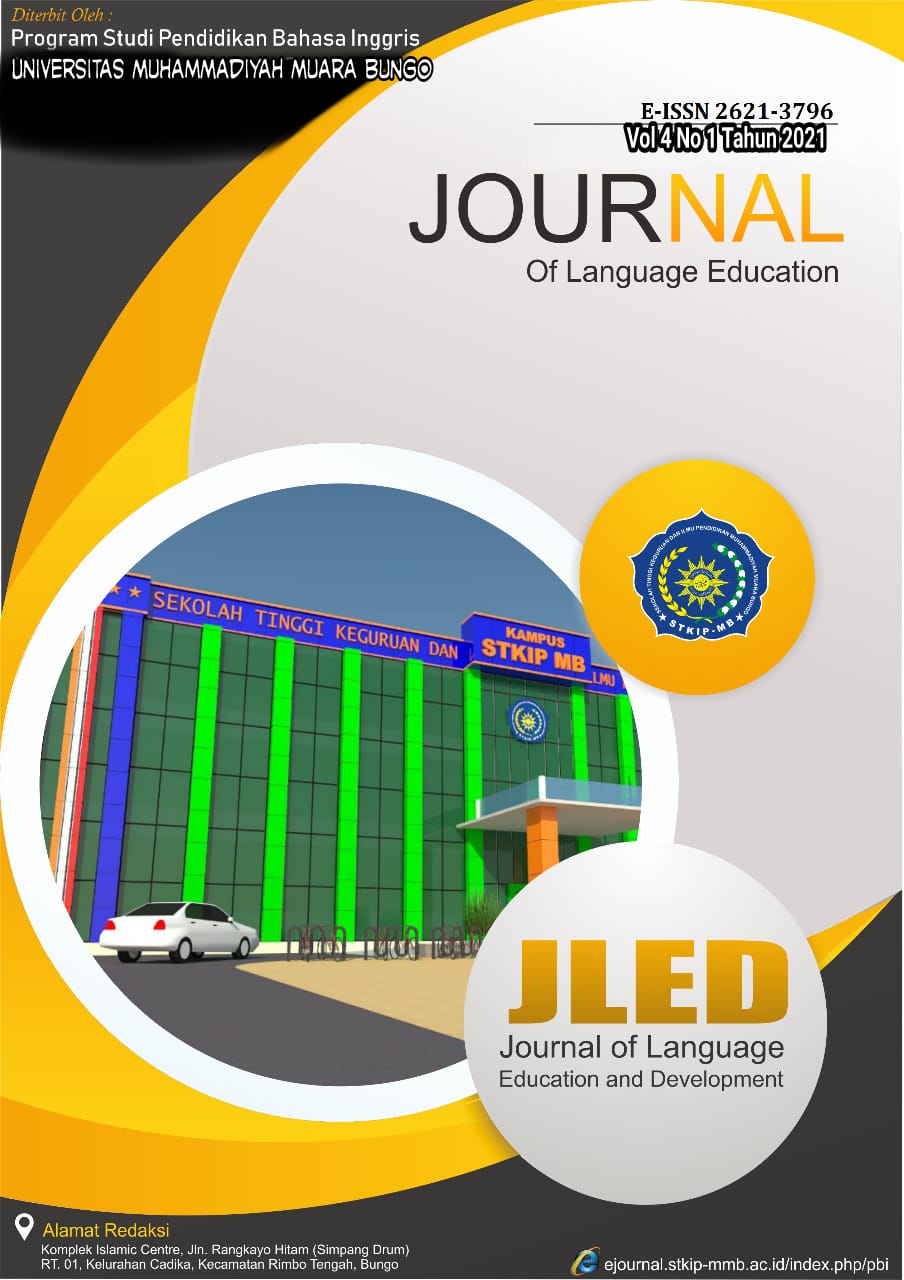A Case Study: Student’s Anxiety in Learning English at the 7th Grade of SMP Negeri 3 Muara Bungo
Abstrak
Tujuan dari penelitian ini adalah untuk mengetahui kecemasan berbahasa asing (Bahasa Inggris) siswa kelas 7 SMPN 3 Muara Bungo. Secara khusus, ini berusaha untuk mengidentifikasi faktor-faktor apa yang dapat berkontribusi terhadap kecemasan dalam lingkungan belajar bahasa Inggris berdasarkan perspektif siswa. Metode yang digunakan dalam penelitian ini adalah metode kualitatif dengan pendekatan studi kasus. Lima belas siswa cemas dipilih sebagai peserta. Data dikumpulkan melalui wawancara terstruktur dan observasi kelas. Hasil penelitian menunjukkan bahwa berbicara di depan kelas, ditertawakan oleh orang lain, masukan yang tidak dapat dipahami, keyakinan siswa tentang pembelajaran bahasa, kepribadian guru, dan kurangnya persiapan adalah enam faktor yang dapat menyebabkan kecemasan siswa dalam belajar. belajar bahasa Inggris
Referensi
Brown, H. Douglas. 1991. Breaking the Language Barrier. Yarmouth: Intercultural Press, Inc.
Bungin, Burhan. 2007. Penelitian Kualitatif. Jakarta: Kencana Predana Media Group.
Carlson, Neil R., and William, Buskist. 1997. Psychology: The Science of Behavior. Needham Heights: Viacom Company.
Chan, D. Y., and Wu, G. 2004. A Study of Foreign Language Anxiety of EFL Elementary School Students in Taipei Country, Journal of National Taipei Teachers College, Vol. 17.
Creswell, J.W. 2012. Educational Research: Planning, Conducting, and Evaluating Quantitative and Qualitative Research, Fourth Edition. Boston: Pearson Education, Inc.
Fraenkel, J. R., and Wallen, N. E. 2009. How to Design and Evaluate Research in Education: Seventh Edition. New York: The McGraw-Hill Companies,
Halgin, Richard P., and Susan, Krauss W. 2007. Abnormal Psychology: Clinical Perspectives on Psychological Disorders. New York: McGraw-Hill.
Horwitz, E. K., et. al., 1986. Foreign Language Anxiety, The Modern Language Journal. Vol. 70.
Horwitz, E. K. and Dolly, J. Young. 1991. Language Anxiety: from Theory and Research to Classroom Implications. New Jersey: Prentice-Hall Inc.
Iizuka, Keiko. 2010. Learner Coping Strategies for Foreign Language Anxiety, JALT2009 Conference Proceedings.
Marwan, Ardi. 2007. Investigating Students’ Foreign Language Anxiety, Malaysian Journal of ELT Research. Vol. 3.
Ormrod, J. E. 2011. Educational Psychology: Developing Learner. Boston: Pearson Education Inc.
Passer, Michael W., and Ronald E., Smith. 2009. Psychology: The Science of Mind and Behavior. New York: McGraw-Hill.
Schutz, Ricardo. “Stephen Krashen’s Theory of Second Language Acquisition”, http://www.sk.com.br/sk-krash.html, 30th November 2013.
The National Science Foundation, “Analyzing Qualitative Data”, http://www.nsf.gov/pubs/ 1997/nsf97153/chap_4.htm, 2013.
Williams, K. E., and Andrade, M. R. 2008. Foreign Language Learning Anxiety in Japanese EFL University Classes: Causes, Coping and Locus of Control, Electronic Journal of Foreign Language Teaching. Vol. 5 No. 2.
Worde, R. V., 2003. Students’ Perspectives on Foreign Language Anxiety, Inquiry. Vol. 8 No. 3.
Wrench, Jason S., et. al. 2014. “What is Communication Apprehension?”, www. 2012books.lardbucket.org/books/public-speaking-practice-and-ethics/s06-01-what-is-communication-apprehen.html,
Young, D. J. 1999.Affect in Foreign Language and Second Language Learning: a Preactical Guide to Creating a Low-Anxiety Classroom Atmosphere. Boston: McGraw-Hill.
| Keywords | : | |
| Galleys | : | |
| Diterbitkan | : |
2022-08-10
|
| Cara Mengutip | : |
Fatmawati, F. (2022). A Case Study: Student’s Anxiety in Learning English at the 7th Grade of SMP Negeri 3 Muara Bungo. Journal Of Language Education and Development (JLed), 4(1), 38–43. https://doi.org/10.52060/jled.v3i2.829
|
| Terbitan | : |









2.png)
1.png)
